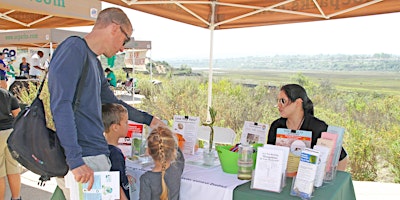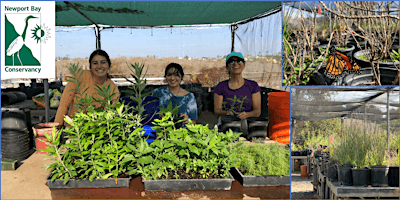
Eelgrass in Lower Bay
Just what is eelgrass and why is it important?
Adapted from an Article by Marine Biologist Rick Ware that appeared in the September 2010 edition of Tracks
Eelgrass (Zostera marina) is one of about 50 species of submerged aquatic vegetation that grow primarily in estuaries and shallow bays. Prior to the 1969 storms, about eight acres of eelgrass were known to exist in Upper Newport Bay between the PCH Bridge and Middle Island. Today, less than 50 square feet are growing, due to high turbidity and an overabundance of nutrient input from the watershed. In Lower Newport Bay, eelgrass is much more abundant. It covers about 69 acres of soft bottom habitat.
Eelgrass is not a seaweed—it is a perennial flowering plant and grows both by vegetative growth and by seed germination. Eelgrass flowers are tiny and inconspicuous, with both female and male parts on the same spike. Pollen is spread either on or under the water surface by currents. After fertilization, the seed develops within a capsule, which eventually ruptures and releases the seed. After being dispersed by waves and currents, the seed sinks to the bottom and germinates. Eelgrass can also reproduce vegetatively, i.e. asexually. The plants have underground, horizontal stems called rhizomes that spread and produce shoots. Eelgrass needs adequate light to survive and will not grow in areas with persistent high levels of suspended sediments and/or over-abundance of plankton which cloud the water.
Eelgrass is one of the most productive and valuable resources on earth. Unfortunately it is also one of the most threatened habitats worldwide. Economically, eelgrass is more than twice as important as salt marsh or mangrove, and three to eight times as important as coral reef and tropical rain forest, based upon commercial and recreational fisheries, jobs, tourism, and other economic indicators. From a local recreational standpoint, eelgrass meadows in Lower Newport Bay provide fishing opportunities for boat and kayak fishermen This translates into a consistent economic base for businesses within Orange County including the recreational fishing industry, boat and kayak rental/retail stores, and food concessions.
Like all plants, eelgrass produces oxygen as a byproduct of photosynthesis. Eelgrass meadows increase the level of dissolved oxygen in the water contributing to the abundance of fish and other marine life. Eelgrass provides an added vertical component to a mostly featureless, soft bottom habitat. It attracts microbes, algae, invertebrates (including lobsters, crabs, worms, snails and clams) and fishes. Some fish (such as pipefish and kelpfish) are life-long residents in the eelgrass meadows. Others (such as barred sand bass, spotted sand bass and California halibut) utilize eelgrass during their juvenile life stages. Still others
(such as topsmelt, anchovy, perch, round stingrays and kelp bass) seek food in the meadow on a daily or opportunistic basis. The abundance of fish provides an important feeding ground for foraging seabirds including the endangered California least tern.
In addition to providing shelter for marine life, eelgrass enhances seafloor stability and baffles water flow. Its dense intertwined rhizome system forms a strong mat that penetrates the bottom and secures the plant and sediment against movement. Its upright blades form a three-dimensional baffle in the water that softens the impact of waves and currents preventing coastal erosion and providing a calm space where organic matter and sediments are deposited.
In an estuarine environment such as Newport Bay eelgrass beds can serve as a nutrient sink and sediment filter; consequently, eelgrass can improve the clarity of the water if sediment and nutrient input from the watershed does not limit light penetration to the extent that eelgrass will not grow. One of the key objectives of the Upper Newport Bay dredging project that is nearing completion is the capture of fine sediment particles associated with stormwater flowing into the bay during heavy winter rains. As turbidity is decreased opportunities will exist to reestablish eelgrass in the Upper Bay, through agency- or privately-funded restoration programs or mitigation programs required for unavoidable losses in the Lower Bay. Per the City of Newport Beach Land Use Plan losses are required to be mitigated at a ratio of 1.2 to 1.
The National Marine Fisheries Service is developing a southern California regional-wide eelgrass monitoring program to:
(1) address the importance of eelgrass systems directly in the path of watershed nutrient and sediment inputs;
(2) respond to climate change issues;
(3) improve regulatory processes;
(4) coordinate existing eelgrass studies between consulting firms, agencies, and managers; and
(5) address emerging threats to southern California eelgrass systems.
This program will also address management strategies, identify priorities and/or new strategies, support the development/implementation of resource management plans, provide performance metric for water quality management, assist in cost effective eelgrass conservation, and streamline reporting of monitoring data and improve accessibility of data.









